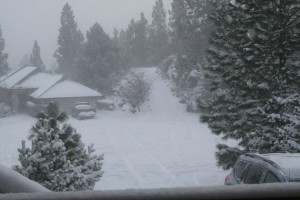Probably the most common question about Dutch oven cooking is: What do I need to get started?
Here’s what I take to elk camp in October, and what I’d recommend you get as part of your urban and wilderness survival kit!
During virtually any emergency, you will need a cooking tool that can bake, boil, fry and sauté. And it should be able to function with a variety of heat sources, since electricity will probably be out.
My nomination for this wonder implement has been around for hundreds of years. It’s easy to find, cheap and effective. Get a cast iron or aluminum Dutch oven. This cooking tool has a proven track record, and it can use virtually any heat source.
A Dutch oven can be used to boil water, make a stew, bake bread, and cook virtually anything that can be fitted inside. And if you were forced to evacuate an area, a camp and/or Dutch oven is compact and light enough to be easily transported.

A winter storm can make travel particularly dangerous. And if the electricity goes out, you’ll have the added challenge of cooking!
Flashback: Hurricane Katrina was due to hit land in a few hours, and my relatives in Mississippi, about 150 miles north of New Orleans, weren’t sure what was going to happen. I overheard my wife talking on the phone to her sister, Patti, of Clinton, Mississippi. In the middle of the hurricane preparation discussion, they started talking about recipes and what to cook, using a cast iron Dutch oven!
Everyone near Katrina faced a potential power outage that could last indefinitely. There was a discussion of evacuating, versus staying put. Among the urban survival necessities in any natural disaster is a way to cook and purify water by boiling.
We had given Patti a hand-me-down cast iron camp oven with the lipped lid and three legs. Designed to be heated on top and bottom with campfire coals or charcoal, the camp oven was considered a necessity on the American frontier for at least two centuries. That type oven was taken on the Lewis and Clark expedition, was used by travelers on the Oregon trail, and was indispensable in countless cabins, lean-tos and soddies.
Technically, a “Dutch” oven has a rounded top and no legs and can be used in a conventional oven on top of a stove, or on an outdoor propane fish cooker of grill.

The Camp oven, left and the Dutch oven will both work well in off-grid cooking.
My wife’s advice to her sister was to get at least 50 pounds of charcoal and three round, 14-inch diameter metal pet food dishes. Put the oven, these items and some basic cooking utensils in a square milk crate for storage.
I’ve been cooking with Dutch ovens at hunting and fishing camps for decades, and on many camping trips and Boy Scout and Girl Scout outings. Beginners frequently ask for a list of tools to get started in Dutch oven cooking. Here is the basic, bare-bones list of Dutch oven survival kit necessities.
-
- 1 – 12-inch shallow cast iron oven: I like Lodge cast iron, because it has a proven quality record, but that’s just personal preference. Camp Chef makes another good product, and several experienced Dutch oven cooks I know prefer that brand. Chose what you like, but be careful: You’ll get what you pay for. A cheap, poorly-made oven won’t work particularly well, and you’ll probably end up replacing it with a quality piece. Sometimes, I take an aluminum oven on outdoor excursions instead of cast iron to save weight.
- 3 – shallow metal pans with lipped rims: These are critical, and common dog or bird food pans work very well. Put one pan underneath the oven to protect the coals from dampness and help regulate heat; and another pan is used to store coals. The third is a spare that is used to cover the oven and protect it from rain or snow while cooking. (Click here to see another use.)
- 1 – lid lifter: In a pinch, a pair of channel lock pliers will work.
- 1 – trivet or tripod: This is a wire or metal rack that holds the lid while you stir the contents of the oven or adjust seasonings. It keeps the lid out of the dirt and clean.
- 1 – knife. You probably don’t need a tactical or survival knife, (even though, in an emergency, any knife you have is a “survival knife”) but you will need something that will work for food preparation.
- 1- nylon spatula: This is used for cooking and cleaning the oven.
- 1 – large nylon spoon.
- Source of heat: Charcoal is easy to use, and and provides an easy method of regulating heat. Make sure you have an adequate supply!
The lid lifter, trivet, “survival knife,” spatula and spoon all fit inside the oven. (If they don’t trim the handles.) All these items fit into a nylon commercial Dutch oven holder. Another great way to carry everything is in a square milk crate. Put the metal pans on the bottom, and the oven won’t tip over. The loaded crate stacks nicely.
Cleaning a Dutch oven is easy. Take the spatula, scrape out any food residue, and fill it with water. (Never put cold water into a hot oven. It might cause it to crack.) Put the oven back on the coals, and boil the water. Usually this will be enough to clean the oven, and all that remains is to scrape out the softened food debris and wipe it dry. Hit the cast iron with a light film of oil to protect against rust.
Obviously, there are other “nice-to-have” cooking items that could be included. But this basic Dutch oven survival kit will get you by.
Please click here to check out and subscribe to the SurvivalCommonSense.com YouTube channel – thanks!





Leave a Reply